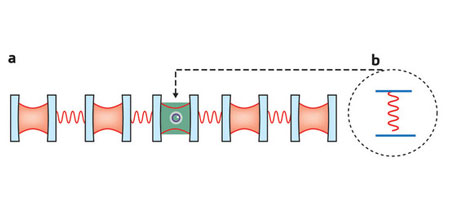| Posted: January 9, 2009 |
A single photon switch |
|
(Nanowerk News) Modern electronics is built upon the control of electric charges through an electric field. Computing based on photons rather than electrons, on the other hand, promises significantly faster computation and information processing. An international team of researchers has now developed a theoretical system that would allow single photons to be controlled reliably.
|
|
“The system we propose can be used as a quantum switch to control the transport of single photons,” says team member Franco Nori from the Advanced Science Institute, Wako, and The University of Michigan, USA.
|
|
In contrast to electrons, exercising control over photons is rather difficult to achieve, because light travels at high speeds and hardly interacts with matter. This has hampered the realization of schemes such as all-optical computing. The use of resonators, however, offers a solution to better control the way light propagates. Resonators are small cavities, bound by mirrors at both ends that bounce light back and only occasionally let light out.
|
|
As reported in the journal Physical Review Letters ("Controllable Scattering of a Single Photon inside a One-Dimensional Resonator Waveguide"), the researchers studied a chain of resonators coupled together so that photons propagate along this line. A system with two energy levels was placed in the center of this coupled-resonator waveguide (Fig. 1). To facilitate the interaction between light and the two-level system the separation of the two energy levels is close to the photon energy.
|
 |
| Figure 1: Schematic diagram of the single photon switch. (a) photons (red) propagate along a line of coupled resonators (blue). (b) Depending on the match between the energy of the photon and the energy of a two-level system (located in one of the resonators, shown in green), the photon is either reflected back or allowed to propagate further.
|
|
When there is a perfect match between the photon energy and the separation of energy levels, the two-level system interacts with the photon; physics then dictates that the photon will be reflected. However, when the energies of the photon and the two-level system do not match, the photon will be transmitted towards the other end of the waveguide.
|
|
“Such a two-level system with adjustable energy levels could be used as a switch that controls the propagation of a single photon in the same way a transistor controls the transport of electrons,“ says team member C. P. Sun from The Chinese Academy of Sciences, Beijing.
|
|
To realize this two-level system the researchers suggest using so-called superconducting qubits, used in connection with superconducting resonators, which have been demonstrated already, as the waveguides. The separation of the qubit energy levels can be easily controlled and could even be done with another single photon. The researchers have demonstrated theoretically that, with the right choice of system parameters, switching can be easily achieved. “We believe such a system is well within reach of current technology,” says RIKEN’s Lan Zhou.
|

